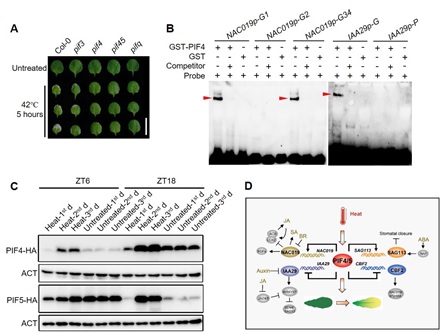The frequency and intensity of extreme high temperature weather increase accompanying global warming. Correspondingly, heat stress induced leaf premature senescence has greatly affected plant growth and development. Nevertheless, the molecular mechanisms of leaf senescence induced by heat stress is still lacking of systematic understanding.
A research group led by professor Prof. WANG Lei, from the Institute of Botany, Chinese Academy of Sciences (IBCAS), has recently made progress in understanding the Phytochrome Interacting Factors (PIFs), which are crucial integrators of light and temperature signals in Arabidopsis thaliana, can promote heat stress-induced leaf senescence.
The researcher group firstly examined the sensitivity of rosette leaves of both mutants and overexpression lines of PIFs in response to heat stress. They found that PIFs mutants displayed a significantly delayed heat stress-induced leaf senescence phenotype, whereas the elevated PIFs levels in transgenic lines could accelerate heat stress-induced leaf senescence. Transcriptome analysis combined with previous ChIP-seq data revealed that NAC019, SAG113, IAA29, CBF2 and BRI1 were the potential targets of PIF4 and PIF5 proteins to mediate heat-induced leaf senescence.
Meanwhile, researchers found that PIF4 and PIF5 proteins were gradually accumulated during the recovery after heat shock treatment, and the transcript levels of NAC019 and SAG113, who can facilitate leaf senescence, were also gradually accumulated, but the transcript level of leaf senescence inhibitor IAA29 was continuously decreased, suggesting that they might be the key target genes of PIF4 and PIF5 to regulate heat-induced leaf senescence.
Furthermore, they showed that light/dark signals and circadian clock played important roles in heat stress-induced leaf senescence. Interestingly, Arabidopsis thaliana was more tolerant to heat stress-induced leaf senescence in the daytime under LD conditions (12h light/12h dark). Intriguingly, the heat induced leaves senescence was even faster on subjective day and slower on subjective night under continuous light condition.
“The study thus established a molecular framework for deciphering the underlying mechanisms of PIF4 and PIF5 in mediating heat stress-induced leaf senescence, and provided a candidate target for generating heat resistant crops to better cope with climate warming,” said Prof. WANG Lei, the correspondence author of the study.
These findings were published online in Journal of Experimental Botany.

Molecular mechanism of PIFs in regulating heat stress induced leaf senescence
Article link:
https://academic.oup.com/jxb/advance-article/doi/10.1093/jxb/erab158/6215381
Contact Info:
Email: wanglei@ibcas.ac.cn
Institute of Botany, Chinese Academy of Sciences
The frequency and intensity of extreme high temperature weather increase accompanying global warming. Correspondingly, heat stress induced leaf premature senescence has greatly affected plant growth and development. Nevertheless, the molecular mechanisms of leaf senescence induced by heat stress is still lacking of systematic understanding.
A research group led by professor Prof. WANG Lei, from the Institute of Botany, Chinese Academy of Sciences (IBCAS), has recently made progress in understanding the Phytochrome Interacting Factors (PIFs), which are crucial integrators of light and temperature signals in Arabidopsis thaliana, can promote heat stress-induced leaf senescence.
The researcher group firstly examined the sensitivity of rosette leaves of both mutants and overexpression lines of PIFs in response to heat stress. They found that PIFs mutants displayed a significantly delayed heat stress-induced leaf senescence phenotype, whereas the elevated PIFs levels in transgenic lines could accelerate heat stress-induced leaf senescence. Transcriptome analysis combined with previous ChIP-seq data revealed that NAC019, SAG113, IAA29, CBF2 and BRI1 were the potential targets of PIF4 and PIF5 proteins to mediate heat-induced leaf senescence.
Meanwhile, researchers found that PIF4 and PIF5 proteins were gradually accumulated during the recovery after heat shock treatment, and the transcript levels of NAC019 and SAG113, who can facilitate leaf senescence, were also gradually accumulated, but the transcript level of leaf senescence inhibitor IAA29 was continuously decreased, suggesting that they might be the key target genes of PIF4 and PIF5 to regulate heat-induced leaf senescence.
Furthermore, they showed that light/dark signals and circadian clock played important roles in heat stress-induced leaf senescence. Interestingly, Arabidopsis thaliana was more tolerant to heat stress-induced leaf senescence in the daytime under LD conditions (12h light/12h dark). Intriguingly, the heat induced leaves senescence was even faster on subjective day and slower on subjective night under continuous light condition.
“The study thus established a molecular framework for deciphering the underlying mechanisms of PIF4 and PIF5 in mediating heat stress-induced leaf senescence, and provided a candidate target for generating heat resistant crops to better cope with climate warming,” said Prof. WANG Lei, the correspondence author of the study.
These findings were published online in Journal of Experimental Botany.

Molecular mechanism of PIFs in regulating heat stress induced leaf senescence
Article link:
https://academic.oup.com/jxb/advance-article/doi/10.1093/jxb/erab158/6215381
Contact Info:
Email: wanglei@ibcas.ac.cn
Institute of Botany, Chinese Academy of Sciences
